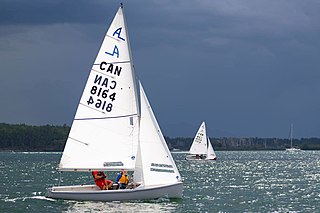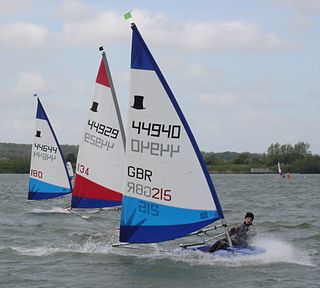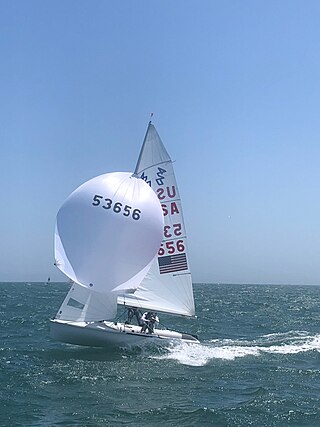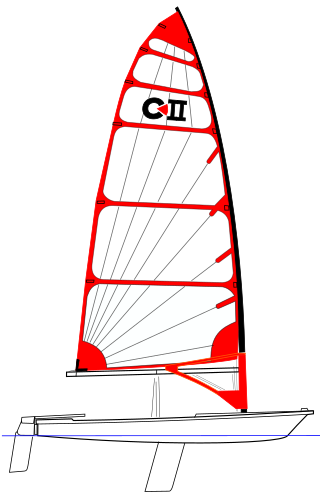
Dinghy sailing is the activity of sailing small boats by using five essential controls:

The Albacore is a 4.57 m (15 ft) two-person planing dinghy with fractional sloop rig, for competitive racing and lake and near-inshore day sailing. Hulls are made of either wood or fiberglass. The basic shape was developed in 1954 from an Uffa Fox design, the Swordfish. Recent boats retain the same classic dimensions, and use modern materials and modern control systems.

The Topper is an 11 foot 43 kg (95 lb) sailing dinghy designed by Ian Proctor. The Topper was a one-design boat until 2023 when a new version was produced, and is sailed mostly around the British Isles. It was recognised as a World Sailing Class. The boat previously constructed from polypropylene, and now roto moulded, is popular as a racing boat or for sail training. The class association (ITCA) organise racing events, which range from small travellers to major championships. The RYA run squads alongside the events; in these squads young sailors who are given specialist race coaching. It is sailed widely among junior sailors in the UK and Ireland and there is a growing fleet in China.

The Laser is a class of single-handed, one-design sailing dinghies using a common hull design with three interchangeable rigs of different sail areas, appropriate to a given combination of wind strength and crew weight. Ian Bruce and Bruce Kirby designed the Laser in 1970 with an emphasis on simplicity and performance.

The 470 (Four-Seventy) is a double-handed monohull planing dinghy with a centreboard, Bermuda rig, and centre sheeting. Equipped with a spinnaker, trapeze and a large sail-area-to-weight ratio, it is designed to plane easily, and good teamwork is necessary to sail it well. The name comes from the boat's length of 470 centimetres.

The Optimist is a small, single-handed sailing dinghy intended for use by young people up to the age of 15.

The International 420 Dinghy is a sailing dinghy popular for racing and teaching. The hull is fiberglass with internal buoyancy tanks. The 420 has a bermuda rig, spinnaker and trapeze. It has a large sail-area-to-weight ratio, and is designed to plane easily. The 420 is an International class recognised by World Sailing. The name refers to the boat's length of 420 centimetres.

The Byte is a small one-design sailing dinghy sailed by one person. It was designed by Canadian Ian Bruce, who also commissioned and marketed the Laser.

The Fireball is a British sailing dinghy that was designed by Peter Milne as a one-design racer and first built in 1962.

The RS300 is a modern racing sailing dinghy made by RS Sailing. The RS300 is a one-design, single-handed, hiking dinghy with a PY of 972. Designed by Clive Everest and first produced in 1998, it is inspired by the International Moth, of which Everest was a successful designer.

The RS800 is a light-weight sailing dinghy designed by Phil Morrison and manufactured by RS Sailing. The boat is sailed by two people both on trapeze and has a main, jib and spinnaker. The RS800 has a Portsmouth Yardstick number of 799 and a D-PN of 77.0. There is a large racing circuit in the UK, and some European events each year.
The RS Vareo is a modern, single-handed sailing dinghy raced throughout the UK at both club and national level. The RS Vareo is a hiking singlehander with an asymmetric spinnaker.

The RS Feva is a two-person sailing dinghy designed by Paul Handley in 2002. It is manufactured and distributed by RS Sailing. The RS Feva is an International Sailing Federation (ISAF) International Class, a Royal Yachting Association (RYA) Supported Junior Class, and has been selected by the Dansk Sejlunion and Norges Seilforbund for major sailing growth projects.
The Splash Dinghy is 3.5 m in length and all boats are identical, thus, as is typical in One-Design classes, the sailor's ability rather than equipment is emphasised fleet racing. The boats employ an un-stayed mono rig with a sail area of 6.3 m2, which makes the class easy to handle by sailors ranging from 45 to 80 kg. This, combined with the low hull weight of 55 kg, allow the class to serve as a stepping stone between the Optimist Dinghy and boats such as the Laser Radial, suiting sailors in the age range from 13 to 21 years.
The RS700 is a single-handed racing dinghy built by RS Sailing and designed in 2000 by Nick Peters and Alex Southon as part of the RS series and built in 2001. It is raced in many sailing clubs around Britain, with a PY number of 850 and a D-PN of 73.3.

The Buzz is a sailing dinghy designed in 1994 by Ian Howlett and John Caig and manufactured by Reg White Limited of Brightlingsea as part of the "White Formula" range of boats originally marketed by Topper International Ltd but since 2013 by Vantage Sailing. The Buzz is a double handed racing boat, with a single trapeze for the crewman. The boat has a fully battened mainsail, furling jib and an asymmetrical spinnaker. There have been around 500 boats built. The Buzz is designed to be an easy to sail boat, but it can also be raced competitively.

The RS Tera is a one-man monohull dinghy in the RS Sailing range of sailing boats. It is recognised by the International Sailing Federation (ISAF) as an international class, and is a popular boat for beginners and for children to race.

RS Sailing is an international designer, builder and supplier of sailboats and dinghies and associated goods and services supported by a worldwide dealer network and class associations.

The RS Aero is a British sailing dinghy that was designed by Jo Richards as a one-design racer and first built in 2014.

The Waszp is an Australian, single-handed, hydrofoiling sailboat that was designed by Andrew McDougall as a one-design racer for youth and adults, and first built in 2016.
















